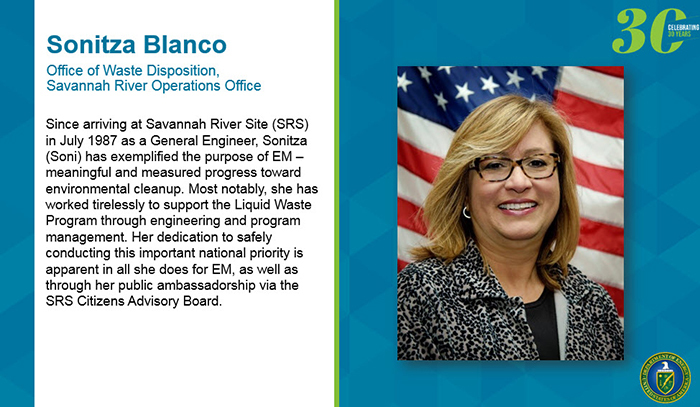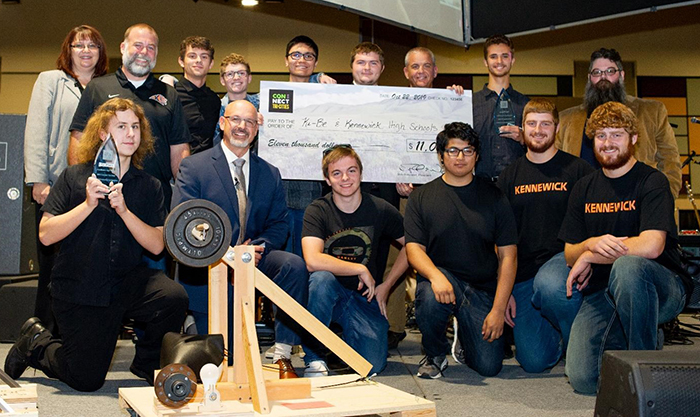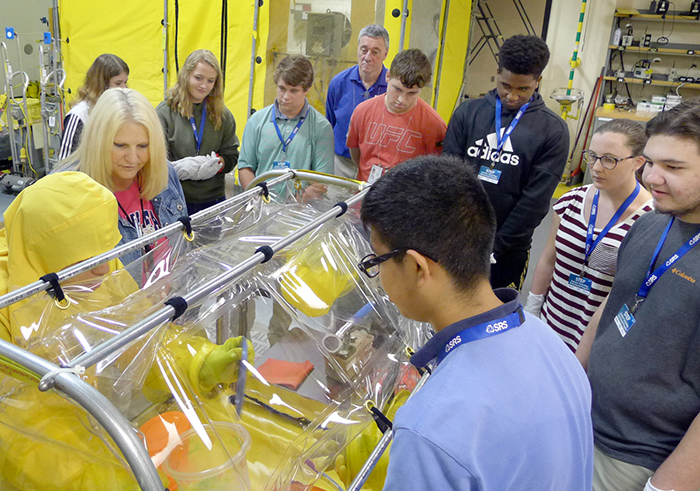|
Members of the West Valley Citizen Task Force, a community advisory group, tour the West Valley Demonstration Project Site. Employees at the site regularly communicate with stakeholders about the site’s environmental stewardship efforts.
WEST VALLEY, N.Y. – Employees at EM’s West Valley Demonstration Project (WVDP) Site routinely communicate their efforts to be good stewards of the environment to a variety of people, from stakeholders in the surrounding community to the site’s cleanup crews.
These robust, easy-to-understand communications — highlighted on WVDP’s website and social media, and in employee messages, newsletters, and meetings — have drawn positive feedback.
An auditor on behalf of the International Organization for Standardization commended WVDP for its effective communication plan focused on keeping internal and external stakeholders informed of environmental work and cleanup progress. The site’s best practices in environmental communications also caught the eye of Una Song, a senior advisor in DOE’s Office of Sustainable Environmental Stewardship in Washington, D.C. At the time, Song had been looking to update training procedures for environmental management systems, which are used at DOE facilities to achieve environmental compliance and sustainability objectives. “I was impressed by the quality and quantity of the communications West Valley does in support of their environmental management system,” Song said. “They are able to do so much because communication is a shared priority for everyone on the team. They are doing a great job.”
Song worked with WVDP to create an environmental information brief, a first-of-a-kind case study that was shared with sites across the DOE complex. Song plans to issue more briefs from other DOE sites in the future.
Among WVDP’s best practices, new employees are trained in the site’s environmental policy. Employees work with the site’s communication manager to pursue new ways to communicate information about projects with stakeholders. A quick reference guide is distributed to all employees with key information on safety, policy adherence, and environmental compliance. And staff members at all levels help improve the environmental management system, which in turn advances the site’s environmental practices.
“The strength of WVDP’s environmental management system is that teams having different roles and responsibilities within the organization work well together and share information effectively,” EM WVDP Regulatory Strategies Support Service Consultant Joseph Forti said. “Continual improvement requires a commitment at all levels, from top leadership to operators to staff. This commitment is demonstrated at the WVDP.”
-Contributor: David Sheeley
Back to Top
 Back to Top
 About 1,200 students, veterans, community leaders, and others attended the 2019 Connect Tri-Cities event. The focus was to help connect the next generation workforce with opportunities in the community, including those relating to the Hanford cleanup mission.
RICHLAND, Wash. – EM Richland Operations Office (RL) contractor Mission Support Alliance (MSA) recently hosted the 2019 Connect Tri-Cities, an event that brought together 1,200 high school students, job seekers, employers, educators, labor union representatives, tribal members, veterans, and others to help build the local workforce of the future.
Celebrating its third year, Connect Tri-Cities focused on addressing the challenges of a retiring workforce and connecting the next generation of workers with the EM cleanup mission. The full-day event featured speakers, informational booths, and breakout sessions.
Connect Tri-Cities included a job fair, one-on-one resume and interview workshops, science demonstrations, digital media influencer presentations, and more.
EM Hanford Site Manager Brian Vance said community events such as Connect Tri-Cities play a critical role in building the future workforce.
“I want to thank all of our partners who help make this event a success year after year,” Vance said. “By coming together, we are able to better identify needs and opportunities in the local workforce. At Hanford, this is especially important as nearly 35 percent of our workforce will be eligible for retirement in the next five years.”
 |
|
Hanford Site Manager Brian Vance addresses attendees at the third annual Connect Tri-Cities event. Celebrating its third year, Connect Tri-Cities focused on connecting the next generation of workers with the EM cleanup mission. |
 Seventeen teams of high school students competed in the Connect Tri-Cities science, technology, engineering and mathematics (STEM) program competition. Teams from Kennewick and Kiona-Benton high schools tied for first place and are shown here with Mission Support Alliance (MSA) leadership representatives. MSA awarded more than $28,000 in scholarships.
Connect Tri-Cities also included a high school science, technology, engineering, and mathematics (STEM) program scholarship competition. Seventeen teams of students competed for more than $28,000 in scholarships, awarded by MSA.
“In partnership with the community, this event gives us an excellent opportunity to engage younger generations and show them the opportunities that exist for their future,” said Bob Wilkinson, MSA president. “From trades and skilled labor to college and certification programs, Connect Tri-Cities encourages students and anyone attending to think more critically about their options. I’m proud of how this has grown into a true community event that is effecting change at Hanford and across the region."
-Contributor: Renee Brooks
Back to Top
 Local high school students who visited Savannah River Site during Nuclear Science Week were challenged to learn more about the properties of radiation by completing tasks that simulate actual working conditions.
AIKEN, S.C. – Every year during Nuclear Science Week, employees at Savannah River Site (SRS) present hands-on demonstrations to local students on a variety of operations at the site.
Held Oct. 14-18 this year, Nuclear Science Week is an international, broadly observed weeklong celebration to focus local, regional, and international interest on all aspects of nuclear science.
During that week, employees with EM contractor Savannah River Nuclear Solutions (SRNS) conducted demonstrations on several topics for the dozens of high school students who visited SRS facilities. The students learned about the use of lasers to align industrial components; virtual reality equipment for employee training; environmental monitoring stations and techniques to sample air, soil, water, plants, and animals; and the properties of radioactive material.
“We believe SRS is an excellent location for students to experience firsthand some of the science-related technologies we work with daily,” said Kim Mitchell, with the SRNS education outreach program.
Mitchell noted that more than 30,000 students and teachers participated in SRNS education outreach programs last year.
“However, only a couple of these programs give students from our region the chance to come away with a better idea of what SRS facilities are like and the wide variety of the tasks accomplished here.”
Freshman Ireland Mack from nearby Silver Bluff High School said it’s important for students to visit SRS and explore different career fields.
“It will open their eyes to lots of opportunities,” Mack said. “This visit will definitely make me consider different career options, like engineering.”
The Nuclear Science Week events at SRS can help transfer knowledge to the next generation of workers as a growing number of employees retire, according to SRNS training instructor Booboo Roberts.
“We’ve been taught how to work safely and securely, protecting the environment, and to do our jobs properly, all of this to help make our nation safe,” Roberts said. “We want to pass that on to the next generation of workers.”
-Contributor: DT Townsend
|